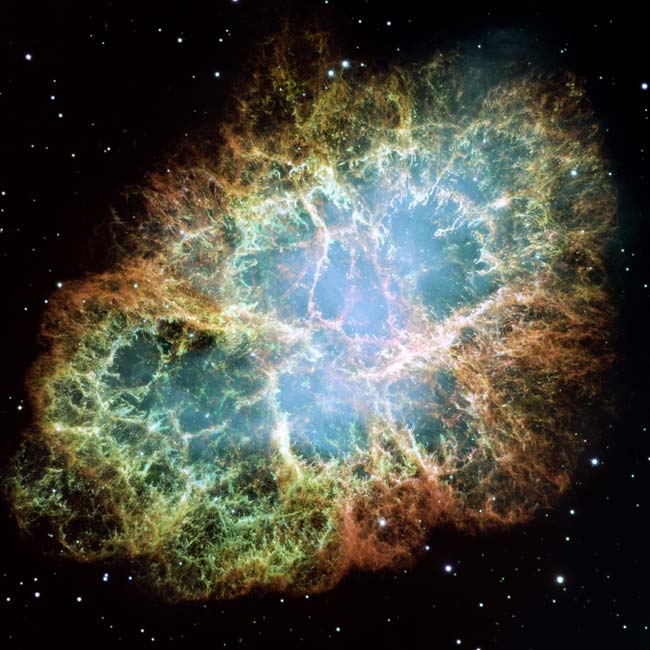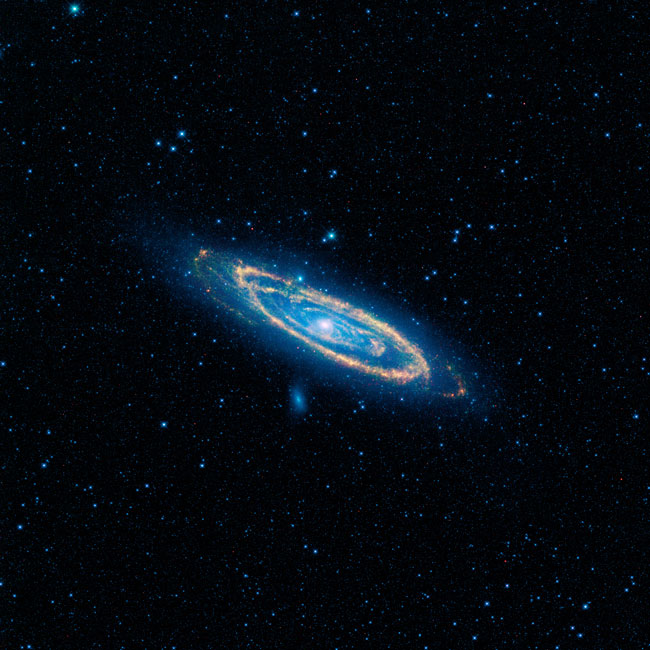NASA's Top 10 Gamma-Ray Sources in the Universe

Gamma-rays are the highest-energy form of light in the universe. Some are generated by transient events, such as solar flares and the huge star explosions known as supernovas. Others are produced by steady sources like the supermassive black holes at the hearts of galaxies.
NASA's Fermi Gamma-ray Space Telescope has been mapping out the high-energy sky since its June 2008 launch. Earlier this year, the Fermi team released its second catalog of sources detected by the instrument's Large Area Telescope (LAT), producing an inventory of 1,873 objects shining in gamma-ray light.
Fermi scientists recently compiled a "top 10 list" to mark the occasion, and to highlight the diversity of gamma-ray sources. Five of the sources on the list are found within our own Milky Way, while the other five reside in distant galaxies.
Fermi's top five sources within our galaxy are:
1. The Crab Nebula: The famous Crab Nebula, located in the constellation Taurus, is the wreckage of an exploded star whose light reached Earth in 1054. Located 6,500 light-years away, the Crab is one of the most-studied objects in the sky. [Supernovas: Photos of Star Explosions]
At the heart of an expanding gas cloud lies what's left of the original star's core, a super-dense neutron star (also called a pulsar) that spins 30 times per second. Until recently, all of the Crab's high-energy emissions were thought to be the result of physical processes near the pulsar that tapped into this rapid spin.
For decades, most astronomers regarded the Crab Nebula as a super-steady beacon at X-ray energies. But data from several orbiting instruments — including Fermi's Gamma-ray Burst Monitor — now show unexpected variations. Astronomers have demonstrated that since 2008, the nebula has faded by 7 percent at high energies, a reduction likely tied to the environment around its central neutron star.
Since 2007, Fermi and the Italian Space Agency's AGILE satellite have detected several short-lived gamma-ray flares at energies hundreds of times higher than the nebula's observed X-ray variations. In April, the satellites detected two of the most powerful gamma-ray flares yet recorded.
Breaking space news, the latest updates on rocket launches, skywatching events and more!
To account for these "superflares," scientists say that electrons near the pulsar must be accelerated to energies a thousand trillion times greater than that of visible light. That's far beyond what can be achieved by the Large Hadron Collider near Geneva, Switzerland, now the most powerful particle accelerator on Earth. [Twisted Physics: 7 Mind-Blowing Findings]
2. W44:Another interesting supernova remnant detected by Fermi is W44. Thought to be about 20,000 years old — middle-aged for a such a structure — W44 is located 9,800 light-years away in the constellation Aquila.
The LAT not only detects this W44, it actually reveals super-energetic gamma-rays coming from places where the remnant's expanding shock wave is known to be interacting with cold, dense gas clouds.
Such observations are important in solving a long-standing problem in astrophysics: the origin of cosmic rays. Cosmic rays are particles, primarily protons, that move through space at nearly the speed of light. Magnetic fields deflect the particles as they race across the galaxy, and this interaction scrambles their path and masks their origins.
Scientists can't say for sure where the highest-energy cosmic rays come from, but they regard supernova remnants as perhaps their likliest origin.
In 1949, the Fermi telescope's namesake, physicist Enrico Fermi, suggested that the highest-energy cosmic rays were accelerated in the magnetic fields of gas clouds. In the decades that followed, astronomers showed that the magnetic fields in the expanding shock wave of a supernova remnant are just about the best location for this process to work.
So far, LAT observations of W44 and several other remnants strongly suggest that the gamma-ray emission arises from accelerated protons as they collide with gas atoms.
3. V407 Cygni: V407 Cygni is a so-called symbiotic binary system — one that contains a compact white dwarf and a red giant star that has swollen to about 500 times the size of the sun.
V407 Cyni lies about 9,000 light-years away in the constellation Cygnus. The system occasionally flares up when gas from the red giant accumulates on the dwarf's surface and eventually explodes. This event is sometimes called a nova (after a Latin term meaning "new star").
When the system's most recent eruption occurred in March 2010, Fermi's LAT surprised many scientists by detecting the nova as a brilliant source. Scientists didn't expect that this type of outburst had the power to produce high-energy gamma-rays.
4. Pulsar PSR J0101-6422: Pulsars — rapidly rotating neutron stars — constitute about 6 percent of the new catalog. In some cases the LAT can detect gamma-ray pulses directly, but in many cases pulses were first found at radio wavelengths based on suspicions that a faint LAT source might be a pulsar.
PSR J0101-6422 is located in the southern constellation of Tucana, its quirky name reflecting its position in the sky.
The Fermi team originally took notice of the object as a fairly bright but unidentified gamma-ray source in an earlier LAT catalog. Because the distribution of gamma-ray energies in the source resembled what is normally seen in pulsars, radio astronomers in Australia took a look at it using their Parkes radio telescope.
Pulsars are neutron stars, compact objects packing more mass than the sun's into a sphere roughly the size of Washington, D.C. Lighthouse-like beams of radiation powered by the pulsar's rapid rotation and strong magnetic field sweep across the sky with every spin, and astronomers can detect these beams if they happen to sweep toward Earth.
The Parkes study found radio signals from a pulsar rotating at nearly 400 times a second — comparable to the spin of a kitchen blender — at the same position as the unknown Fermi source. With this information, the LAT team was able to discover that PSR J0101-6422 also blinks in gamma-rays at the same incredible rate.
5. 2FGL J0359.5+5410: Fermi scientists don't know what to make of this source, which is located in the constellation Camelopardalis. It resides near the populous midplane of our galaxy, which increases the chance that it's actually an object in the Milky Way.
While its gamma-ray spectrum resembles that of a pulsar, pulsations have not been detected, and it isn't associated with a known object at other wavelengths.
The top five sources beyond the Milky Way are:
1. Centaurus A:The giant elliptical galaxy NGC 5128 is located 12 million light-years away in the southern constellation Centaurus. One of the closest active galaxies, it hosts the bright radio source designated Cen A. Much of the radio emission arises from lobes of gas a million light-years wide, which have been hurled out by the supermassive black hole at the galaxy's center. [Photos: Black Holes of the Universe]
Fermi's LAT detects high-energy gamma-rays from an extended region around the galaxy that corresponds to the radio-emitting lobes. The radio emission comes from fast-moving particles. When a lower-energy photon collides with one of these particles, the photon receives a kick that boosts its energy into the gamma-ray regime.
It's a process that sounds more like billiards than astrophysics, but Fermi's LAT shows that it's happening in Cen A.
2. The Andromeda Galaxy (M31): At a distance of 2.5 million light-years, the Andromeda Galaxy is the nearest spiral galaxy to us, one of similar size and structure as our own Milky Way. Easily visible to the naked eye in a dark sky, it's also a favorite target of sky gazers.
The LAT team expected to detect M31 because it's so similar to our own galaxy, which sports a bright band of diffuse emission that creates the most prominent feature in the gamma-ray sky. These gamma-rays are mostly produced when high-energy cosmic rays smash into the gas between stars.
"It took two years of LAT observations to detect M31," Jürgen Knödlseder at the Research Institute for Astrophysics and Planetology in Toulouse, France, said in a statement. Currently a visiting scientist at the SLAC National Accelerator Laboratory in California, he worked on the M31 study.
"We concluded that the Andromeda Galaxy has fewer cosmic rays than our own Milky Way, probably because M31 forms stars — including those that die as supernovae, which help produce cosmic rays —more slowly than our galaxy," Knödlseder added.
3. The Cigar Galaxy (M82): What works for the Andromeda Galaxy works even better for M82, a so-called starburst galaxy that is also a favorite of amateur astronomers. M82 is located 12 million light-years away in the constellation Ursa Major.
M82's central region forms young stars at a rate some 10 times higher than the Milky Way does, activity that also guarantees a high rate of supernovae as the most short-lived stars come to explosive ends.
Eventually, M82's superpowered star formation will subside as the gas needed to make new stars is consumed, but that may be tens of millions of years in the future. For now, it's a bright source of gamma-rays for Fermi.
4. Blazar PKS 0537-286: At the core of an active galaxy is a massive black hole that drives jets of particles moving near the speed of light. Astronomers call the galaxy a blazar when one of these jets is pointed our way — the best view for seeing dramatic flares as conditions change within the jet. [Video: Of Blazars and Black Holes]
PKS 0537-286 is a variable blazar in the constellation Leo and the second most distant LAT object. Astronomers have determined that the galaxy lies more than 11.7 billion light-years away.
The blazar is the farthest active galaxy in the Fermi catalog to show variability. Astronomers are witnessing changes in the jet powered by this galaxy's supermassive black hole that occurred when the universe was just 2 billion years old (it is now about 13.7 billion years old).
5. 2FGL J1305.0+1152: The last item is another mystery object, one located in the constellation Virgo and high above our galaxy's midplane. It remains faint even after two years of LAT observations.
One clue to classifying these objects lies in their gamma-ray spectrum — that is, the relative number of gamma-rays seen at different energies. At some energy, the spectra of many objects display what astronomers call a "spectral break," a greater-than-expected drop-off in the number of gamma-rays seen at increasing energies.
If this object were a pulsar, it would show a fast cutoff at higher energies. Many blazars exhibit much more gradual cutoffs. But 2FGL J1305.0+1152 shows no evidence of a spectral break at all, leaving its nature a true mystery — for now, anyway.
Follow SPACE.com for the latest in space science and exploration news on Twitter @Spacedotcom and on Facebook.

Space.com is the premier source of space exploration, innovation and astronomy news, chronicling (and celebrating) humanity's ongoing expansion across the final frontier. Originally founded in 1999, Space.com is, and always has been, the passion of writers and editors who are space fans and also trained journalists. Our current news team consists of Editor-in-Chief Tariq Malik; Editor Hanneke Weitering, Senior Space Writer Mike Wall; Senior Writer Meghan Bartels; Senior Writer Chelsea Gohd, Senior Writer Tereza Pultarova and Staff Writer Alexander Cox, focusing on e-commerce. Senior Producer Steve Spaleta oversees our space videos, with Diana Whitcroft as our Social Media Editor.




